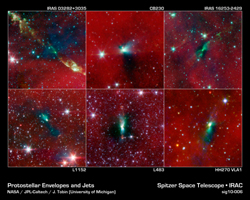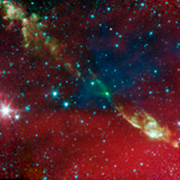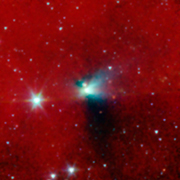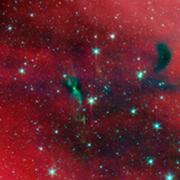
Annotated Poster
 |  |  |
| IRAS 03282+3035 | CB230 | IRAS 16253-2429 |
Click on an individual image for larger viewNew evidence from NASA's Spitzer Space Telescope is showing that tight-knit twin stars might be triggered to form by asymmetrical envelopes like the ones shown in this image. All stars, even single ones like our sun, are known to form from collapsing clumps of gas and dust, called envelopes, which are seen here around six forming star systems as dark blobs, or shadows, against a dusty background. The greenish color shows jets coming away from the envelopes. The envelopes are all roughly 100 times the size of our solar system.
Two of the six envelopes are known to have already formed twin, or binary stars (Spitzer can see the envelopes but not the stars themselves). Astronomers believe that the irregular shapes of these envelopes, revealed in detail by Spitzer, might trigger binary stars to form, or might have already triggered them to form.
From top left, moving clockwise, the stars are: IRAS 03282+3035, CB230, IRAS 16253-2429, L1152, L483, HH270 VLA1. IRAS 03282+3035 and CB230 are the two known to have already formed binary stars.
Infrared light with a wavelength of 3.6 microns has been color-coded blue; 4.5-micron light is green; and 8.0-micron light is red.

